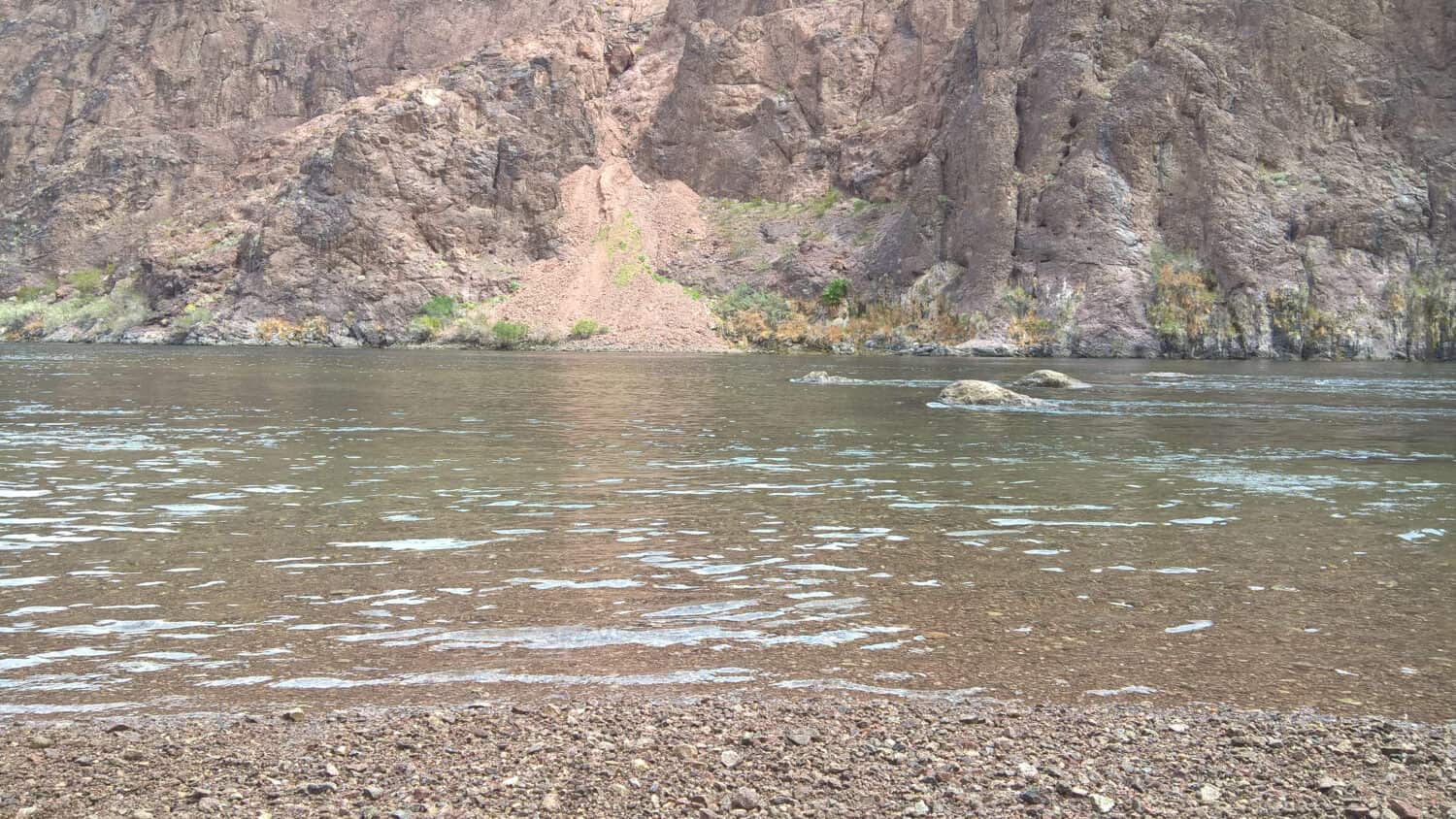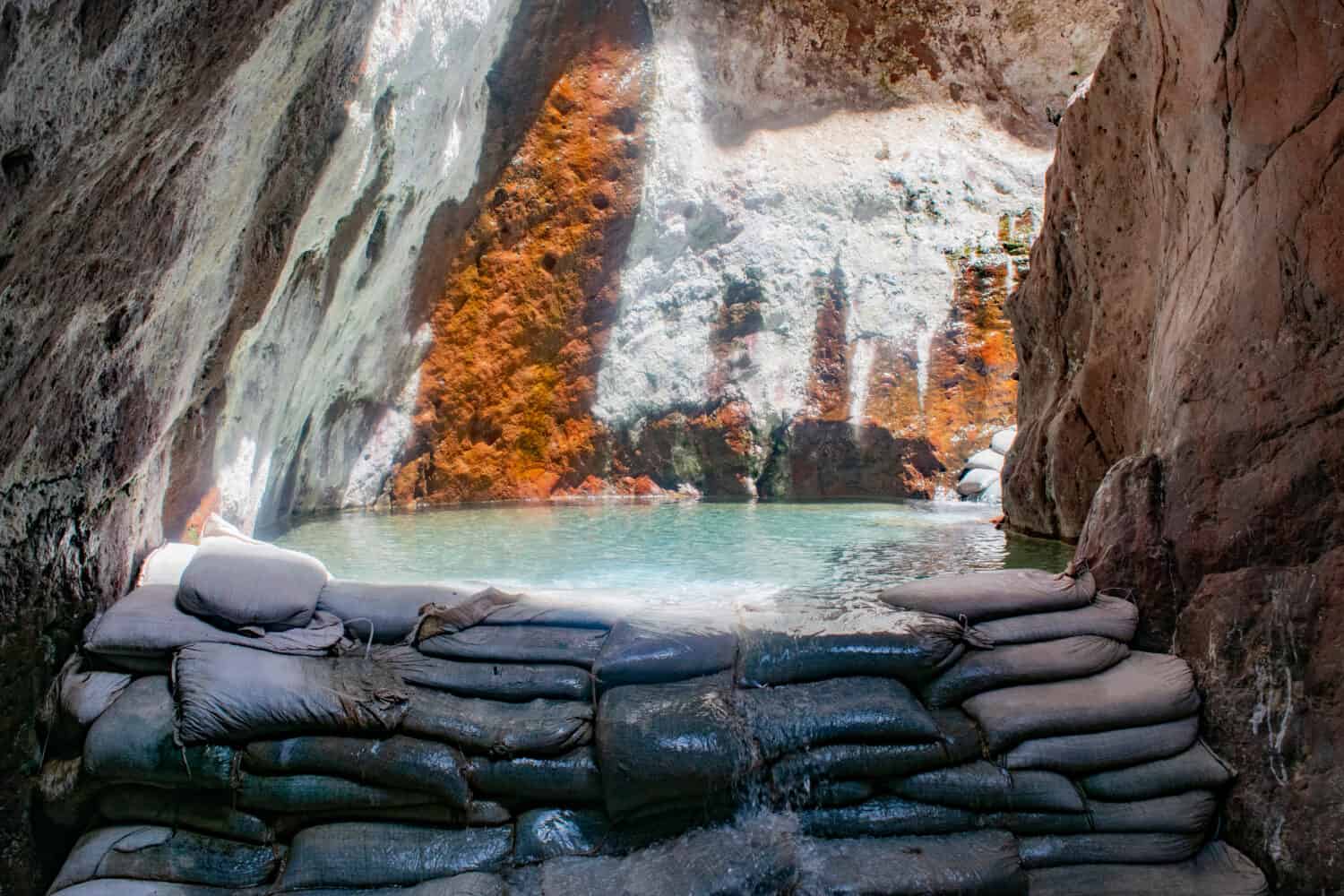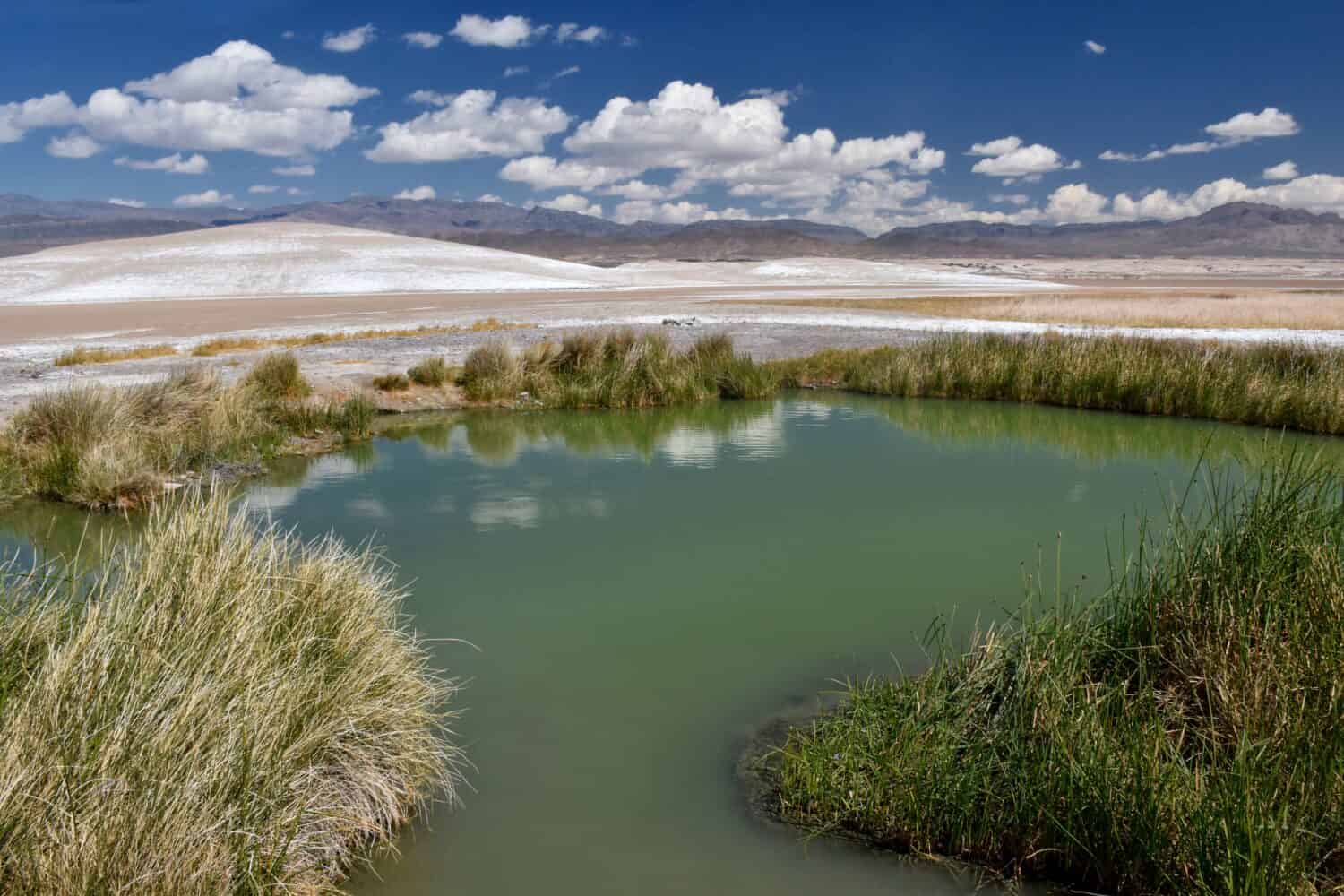People have long sought after hot springs for their rejuvenating and therapeutic properties. These natural wonders offer a natural way to relax, unwind, and soothe both the body and mind.
Their unique geological formation creates an inviting combination of warm water and mineral-rich environments, making them a popular stop for travelers and wellness enthusiasts alike.
Nestled within a short trip of the bustling Las Vegas, Nevada, are several nearby hot springs that provide a welcome retreat from the city’s fast-paced energy.
In this article, we guide you through the best hot springs closest to Las Vegas, delving into their distinct characteristics, accessibility, and nearby attractions. So, immerse yourself in the healing power of these natural wonders and let your worries melt away under the desert sky.
1. Gold Strike Hot Springs

To reach Gold Strike Hot Springs, you will need to hike for around three hours.
©B_Zuber/Shutterstock.com
Located approximately an hour from Las Vegas, Gold Strike Hot Springs is a remarkable oasis amid the rugged desert landscape.
This enchanting destination blends adventure and relaxation, attracting nature lovers and thrill-seekers alike.
Hiking Trail to Reach the Hot Springs
Reaching Gold Strike Hot Springs requires a moderate hike through a scenic canyon.
The 6-mile round-trip trail winds past striking rock formations, narrow passages, and several warm pools before it culminates at the main hot springs area.
With a few boulder scrambles and some rope-assisted descents, this hike promises an exhilarating experience.
Unique Features
Gold Strike Hot Springs’ distinguishing feature is a cascading waterfall that feeds the main pool. The waterfall creates a serene ambiance complemented by breathtaking canyon views.
The spring’s temperatures vary, ranging from pleasantly warm to nearly scalding. Therefore, you must be cautious when selecting a pool to soak in.
Tips for Visiting
The ideal time to visit Gold Strike Hot Springs is during the cooler months of fall and spring. This is because the trail can be extremely hot and dangerous during summer.
Additionally, the area is prone to flash floods, so always check the weather forecast before embarking on your hike.
Remember to bring plenty of water, wear sunscreen, and exercise caution when navigating the trail.
Are They Safe to Swim In?
Although Gold Strike Hot Springs’ pools are generally safe for swimming, be mindful of the varying water temperatures, as some may be too hot for a comfortable soak.
Always test the water before entering, and be aware of the slippery rocks and uneven surfaces that could pose a risk.
Why They Occur in the Area
Gold Strike Hot Springs’ formation is attributed to the region’s unique geology, characterized by fault lines and volcanic activity that heat the groundwater, resulting in the warm pools found along the canyon.
Nearby Attractions
While you visit Gold Strike Hot Springs, consider exploring nearby attractions, such as the Hoover Dam and the Lake Mead National Recreation Area. Both destinations offer a wealth of recreational activities, including sightseeing, boating, and fishing. As a result, it’s a great way to ensure an unforgettable experience in the great outdoors.
2. Arizona Hot Springs

Arizona Hot Springs is also known as the Ringbolt Hot Springs, are inside a canyon near the Colorado River.
©Beth Schroeder/Shutterstock.com
A stone’s throw away from Las Vegas, Arizona Hot Springs is a popular destination for those seeking a rejuvenating escape in the great outdoors. This hidden Arizona gem along the Colorado River is known for its unique setting, invigorating hot springs, and stunning natural surroundings.
Hiking and Kayaking Options to Reach the Hot Springs
Accessing Arizona Hot Springs can be done in two ways:
- By hiking the 5.9-mile round-trip trail through White Rock Canyon
- By kayaking down the Colorado River from Willow Beach
Both options provide an exciting journey, surrounded by the beauty of the desert landscape.
Ladder Access and Multiple Pools
Upon reaching Arizona Hot Springs, visitors are greeted by a series of pools, each with varying water temperatures.
The pools are connected by a 20-foot ladder, adding a sense of adventure to the experience.
Enjoy the soothing warm water and take in the picturesque canyon walls that envelop the area.
Tips for Visiting
The best time to visit Arizona Hot Springs is during the cooler months, as summer temperatures can be dangerously high.
Always check the weather forecast before your visit. Prepare with the following:
- Plenty of water
- Sunscreen
- Appropriate footwear
Avoid visiting during or immediately after heavy rain, as flash floods can occur in the area.
Are They Safe to Swim In?
The pools at Arizona Hot Springs are generally safe for swimming. But it’s essential to be mindful of the water temperature, as some pools may be too hot for comfort.
Test the water before entering, and be cautious of slippery rocks and steep terrain. As always, exercise common sense and respect the natural environment.
Why They Occur in the Area
Arizona Hot Springs is the result of geothermal activity and tectonic forces in the region.
The Earth’s crust’s movement allows heated groundwater to rise to the surface, creating inviting pools within the canyon.
Nearby Attractions
In addition to the hot springs, the area offers several other attractions to explore. Visit the mesmerizing Emerald Cave with its striking green water, or spend a day at Willow Beach, where you can enjoy swimming, fishing, and picnicking along the scenic Colorado River.
These nearby attractions make for a perfect complement to your hot springs adventure.
3. Tecopa Hot Springs

Tecopa Hot Springs’ picturesque background dazzles visitors.
©Kozaru/Shutterstock.com
Tecopa Hot Springs, located in California just 80 miles west of Las Vegas, is a haven for those seeking solace in the healing powers of natural mineral waters.
The springs provide a tranquil retreat with a picturesque desert backdrop that draws in visitors looking for relaxation and rejuvenation.
Indoor and Outdoor Soaking Options
Best of all, Tecopa Hot Springs offers both indoor and outdoor soaking options, allowing visitors to choose the experience that suits them best.
The indoor facilities provide a more private and controlled environment, while the outdoor options immerse you in the natural beauty of the desert landscape.
Whichever you choose, the mineral-rich waters are sure to soothe and refresh.
Accommodations
A range of accommodation options are near Tecopa Hot Springs, catering to different preferences and budgets. There is something for everyone, from campgrounds and RV parks to more upscale resorts.
Many of these facilities offer their own private hot spring pools for guests to enjoy.
Are They Safe to Swim In?
Tecopa Hot Springs’ pools are generally safe for swimming. But it’s essential to be mindful of the water temperature, as some pools may be too hot for comfort.
Test the water before entering. Always ensure that the facilities you visit are well-maintained and adhere to health and safety standards.
Why They Occur in the Area
The formation of Tecopa Hot Springs can be attributed to the region’s volcanic history and nearby fault lines.
These geological features allow groundwater heating, creating the warm, mineral-rich pools that characterize the area.
Nearby Attractions
While visiting Tecopa Hot Springs, explore nearby attractions, such as the China Ranch Date Farm, where you can sample delicious dates and baked goods.
Additionally, the awe-inspiring Death Valley National Park is just a short drive away, offering endless opportunities for sightseeing, hiking, and stargazing.
4. Rogers Spring

One of the best hot springs near Las Vegas, Rogers Springs, is located in the Mojave Desert.
©Sergey Malomuzh/Shutterstock.com
Rogers Spring, situated just an hour from Las Vegas, is a delightful oasis in the heart of the Mojave Desert.
This easily accessible hot spring is a popular destination for families and nature enthusiasts, offering a serene environment to unwind and connect with the outdoors.
Easy Access for All Ages and Abilities
One of the main appeals of Rogers Spring is its accessibility.
With a paved road leading directly to the spring and minimal hiking required, visitors of all ages and abilities can enjoy this natural gem.
The spring itself is surrounded by a small, developed area. Pack lunch, as it’s an ideal spot for picnicking and relaxing.
Unique Features
Rogers Spring is a true desert oasis characterized by its lush vegetation and abundant wildlife.
The spring’s warm waters create a unique microclimate that supports a variety of plant and animal species.
Visitors can enjoy birdwatching and catching glimpses of desert creatures like bighorn sheep and lizards.
Tips for Visiting
The ideal time to visit Rogers Spring is during the cooler months, as summer temperatures can be quite high.
While swimming is allowed, visitors should be aware that it is restricted to certain areas to protect the delicate ecosystem. Be sure to follow posted signs and guidelines during your visit.
Is It Safe to Swim In
Although swimming is permitted in designated areas of Rogers Spring, you must be cautious and respectful of the environment.
The spring is home to a fragile ecosystem that human activity can easily disrupt. Always follow posted guidelines, be mindful of the surrounding wildlife, and avoid using soaps or lotions that could contaminate the water.
Why It Occurs in the Area
Rogers Spring is the result of groundwater interacting with geothermal heat from the Earth’s crust.
The geothermal activity warms the mineral-rich waters, creating the inviting oasis visitors enjoy today.
Nearby Attractions
While visiting Rogers Spring, take the opportunity to explore the nearby Lake Mead National Recreation Area, where you can indulge in water sports, hiking, and sightseeing.
Additionally, the vibrant Valley of Fire State Park is just a short drive away. A 40,000-acre park, it offers stunning red sandstone formations, petroglyphs, and a range of outdoor activities to immerse yourself in the beauty of the desert.
Hot Spring Formation

Hot springs have water that’s hotter than 98 degrees.
©Kosuke Machida/Shutterstock.com
Hot springs are natural wonders that offer warmth, relaxation, and a unique connection to the Earth’s geological processes.
These thermal features, often found in picturesque settings, are formed through complex interactions between water, heat, and the Earth’s crust.
Step 1. The Role of Groundwater and Geothermal Heat
The formation of hot springs begins with the infiltration of rainwater or melted snow into the ground.
This water, known as groundwater, seeps deep into the Earth’s crust and comes into contact with geothermal heat.
The Earth’s internal processes, such as the decay of radioactive elements and the residual heat from the planet’s formation, generate geothermal heat.
Step 2: Heat Transfer
Groundwater heating occurs through conduction, where heat is transferred from the hotter rock to the cooler water.
As the water becomes heated, its density decreases, causing it to rise through a process called convection.
This circulation of heated water forms the basis of a hot spring system.
Step 3: The Influence of Geology
The geology of an area plays a significant role in the formation and location of hot springs.
In regions with faults, fractures, or volcanic activity, heated water can more easily rise to the surface due to the increased permeability of the Earth’s crust.
Faults and fractures provide channels for the heated water to travel, while volcanic activity can create additional heat sources that contribute to the formation of hot springs.
Step 4: Mineral Content
As groundwater travels through the Earth’s crust, it dissolves minerals from the surrounding rock, enriching the water with various elements such as calcium, magnesium, and sulfur.
These minerals are what give hot springs their unique composition and are often believed to offer therapeutic benefits to those who soak in the waters.
Step 5: Hot Springs Emerge
Once the heated, mineral-rich water reaches the surface, it emerges as a hot spring.
The temperature of the water can vary greatly based on:
- The heat source
- The depth of the groundwater
- The rate at which the water rises to the surface
Hot springs offer a fascinating glimpse into the Earth’s geological processes regardless of their specific temperature. They also provide a soothing, natural retreat for visitors to enjoy.
Key Takeaways
Hot springs near Las Vegas offer a unique and rejuvenating experience for those seeking a break from the city’s fast-paced lifestyle.
These natural wonders, formed through complex geological processes, provide a tranquil escape and an opportunity to connect with nature.
Whether you’re looking for adventure, relaxation, or a chance to explore the surrounding attractions, the hot springs near Las Vegas cater to a wide range of preferences and interests.
Thank you for reading! Have some feedback for us? Contact the AZ Animals editorial team.







